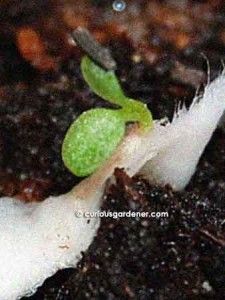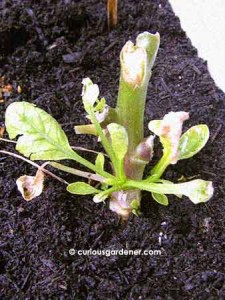
A 2-day old Rudbeckia hirta sprout with the seed casing still attached!
Finally, after many attempts at germinating Rudbeckia hirta seeds, I have succeeded!
I first saw them on Skyfiery’s blog and fell in love with the flowers. It was around the Christmas season last year, and I thought the opening bud looked especially Christmassy. Then when I saw the lovely bright colours of the fully-opened flower, I was a goner. Since we both enjoy growing our plants from seeds, Sky kindly passed me some harvested seeds, and I was off …to many false starts.
Believe me when I say I tried many ways of germinating these seeds – surface sowing on many different media, ziplock sowing when I got more desperate, more surface sowing, and finally – since my caixin had sprouted so readily this way – on damp tissue in an enclosed container. The seeds started germinating in 4 days.

Just to give you an idea of how tiny the sprout is - that's it on the bit of tissue paper, in the middle of a 7cm wide pot. Tiny!
I was eager to transplant the little sprouts as soon as possible, but they had already rooted themselves in the wet tissue! Thankfully, it was a simple matter of tearing off the area of tissue they were attached to and placing that atop the new home – a small pot filled with a Tref mix. The tissue will disintegrate in time, and root shock during transplant is minimized.
I chose to use Tref because I had looked up the correct soil pH for rudbeckias and found it to be between 5.5 to 7 – in my current limited understanding of this, the answer was the black/white mix of peat that is Tref.
So, for better or for worse, the first seedlings are now sitting atop their new homes, and taking no chances, I’ve covered them for now with transparent plastic cups to help keep the humidity in while they stabilize. In the meantime, a few more seeds look like they’re beginning to germinate, too. Let’s hope I can nurture them nicely to maturity!
© 2011 curiousgardener.com All rights reserved.
![]()







